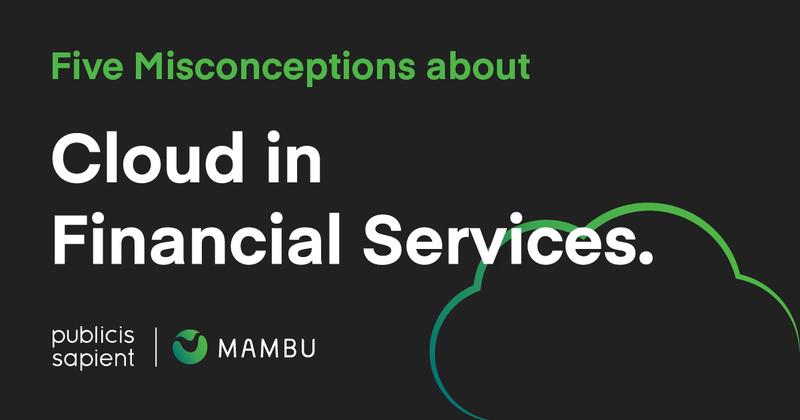According to research by Gartner, the proportion of IT spending that is shifting to the cloud will accelerate in the aftermath of the COVID-19 crisis, with the cloud projected to make up 14.2 per cent of the total global enterprise IT spending market in 2024, up from 9.1 per cent in 2020. Another Gartner survey data indicates that almost 70 per cent of organisations using cloud services today plan to increase their cloud spending in the wake of the disruption caused by the pandemic.
Nevertheless, there are some current beliefs about the cloud, which are based on misconceptions. These beliefs can be an obstacle to understanding the business, operational, and economic benefits of cloud. Companies and executives who effectively counteract these myths are the ones that will derive the most significant rewards from their move to the cloud.
Jan-Willem Weggemans, Senior Client Partner at Publicis Sapient, and Miljan Stamenkovic, General Manager MENA at Mambu, discuss the 5 most common misconceptions about cloud technology in banking.

Misconception 1: Cloud is less secure and can get easily hacked
Security is paramount, so this is a valid concern for clients. Traditionally, banks have secured their on-premise infrastructure, building experience and trust in their security. But over the past few years, Chief Security Officers across the sector have acknowledged that on-premise data centres can be hacked remotely and that it's manual processes and insider threats that pose a significant risk.
Many banks have not yet built up the experience to design cloud foundation in a secure fashion. Cloud providers like Amazon Web Services (AWS), Microsoft, and Google Cloud invest billions of dollars every year to ensure that their solutions are safe and offer top-notch security features, including data encryption and masking (for transfers).
What ultimately drives trust in security depends on banks gathering the relevant experience in implementing security features on their cloud foundation. Also, financial institutions that define the correct policies, adopt a secure DevSecOps operating model, and train or hire the right talent can achieve safer operations in their cloud environments than on-premises.
In summary, security is about growing experiences at the banks to set up cloud environments in a secure way, collaborating with cloud providers to continuously advance security measures in light of the ever-evolving threats.
Misconception 2: The location of the data is unknown
For financial institutions, controlling data access is critical for protecting people's data and privacy and maintaining customer trust. Ownership of data, data residency and data sovereignty are driving conversations amongst C-suite executives, both in new digital banks and established banks.
Many conversations around data residency are sparked by people concerned as private citizens. But it's a very different game when the client is a business customer who can manage data residency in the cloud. For example, leading cloud providers support financial institutions in meeting data residency requirements. Their customers can designate in which data centre region their business-critical data and apps are stored and how and when it can be transferred.
Misconception 3: Cloud is extremely expensive
Cloud expenses are an urban myth. Cloud is the catalyst for a broader business transformation, and benefits can outweigh any expenditure in technology. However, to see savings, there are two things that banks need to do.
First, they need to set up a new cost management capability. They are moving from a fixed cost – including depreciation – into a more variable cost model, supported by new pricing models from cloud providers. Banks must create the brain within the organisation to understand how consumption drives a particular cost and how changes in demand can result in a better cost level.
Secondly, they need to decommission old infrastructure to "bank" the actual savings. That's still a challenging activity for many firms, as often they end up with a data centre that needs to be decommissioned while there's still some applications in there.
Misconception 4: The cloud market is established and requires a one-off transition or strategy
The cloud providers market is developing rapidly in terms of the number of players and what they offer. This requires an ongoing capability at banks to scan the market and update the cloud infrastructure strategy regularly.
Provider examples globally include three leading providers – AWS, Google and Azure. Yet, a long list of credible providers exists, including Alibaba, Oracle and Salesforce, some of which lead in specific regions. In the services arena, cloud providers are growing more active in offering additional and sector-specific services or creating ecosystems with ISVs. This results in a dynamic vendor marketplace, which can provide significant opportunities for banks as they progress on their transformation journey.
Misconception 5: After cloud migration, there is no going back
The CEO will not want to go back, as he/she will not want to give up the capability and financial benefits. Specific apps are simply better when hosted in the cloud and the cloud-native technology allows banks to evolve and improve their broader operating and business models.
In discussions with clients about what workload should move to the cloud first, it's data and digital channels that come up most often. Digital channels often represent applications that are easy to migrate, as they are already microservices-based and which would benefit from the scalability cloud offers. In addition, data allows for AI capabilities to function better in the cloud, as all data can be unified and kept up-to-date, providing the fuel for the AI/ML capabilities.
In conclusion, the cloud is not infrastructure-at-play but rather the catalyst to transform banks end-to-end without compromising safety and security. In addition, the transformation to a cloud-native bank offers the benefit of significantly lower operating costs and new sources of revenues for banks.
